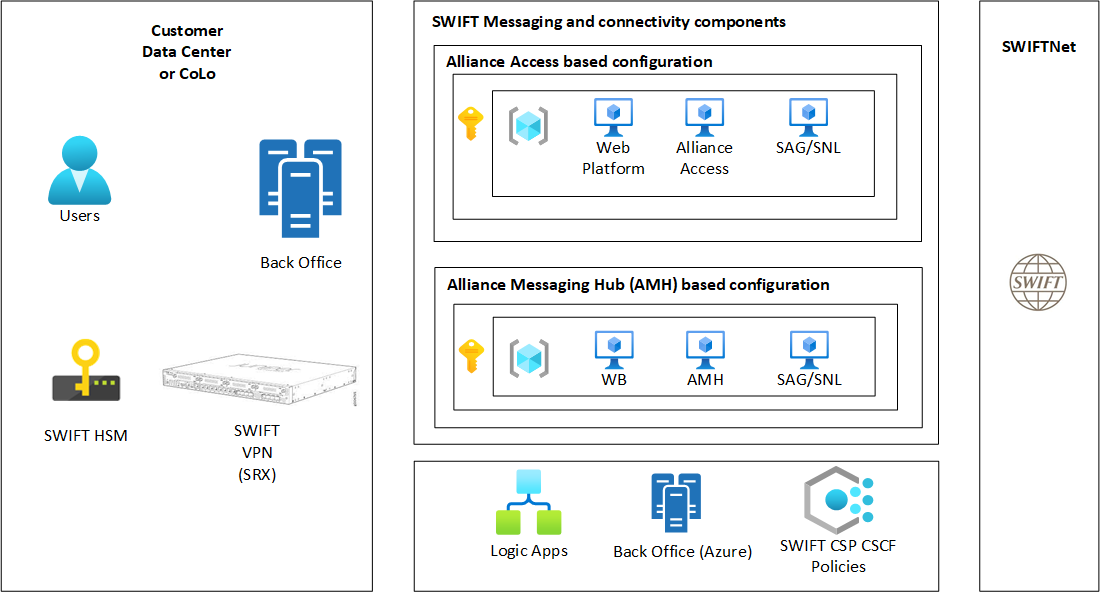SWIFT Alliance Connect in Azure
This series of articles provide guidance on using SWIFT's components in Azure. This article discusses the basic components that the architecture examples use in this series.
The intended audiences for this article are program managers, architects, and engineers who are implementing SWIFT components in Azure. The article is organized into the following structure:
- A high-level overview of Azure architecture to deploy SWIFT's components (this article).
- A detailed reference architecture for each of the components (links below).
Architecture
The following diagram is a high-level Azure reference architecture of connectivity to the SWIFT network based on the Alliance Access and Alliance Messaging Hub (AMH) messaging interfaces. For more information on the SWIFT components, see SWIFT Glossary.

Download a Visio file of this architecture.
A SWIFT deployment in Azure contains various components, and the key ones are explained in the next section.
Customer data center or CoLo
This solution area represents the on-premises site from where business users will interact with SWIFT's components securely. Any other business processing applications running on-premises can also connect with SWIFT's components. There must be network connectivity between this site and Azure, where SWIFT's components are deployed.
SWIFT's Hardware Security Module (HSM)
In accordance with SWIFT's Customer Security Program (CSP) Control Framework (CSCF), the Hardware Security Module (HSM) that SWIFT provides has to be physically hosted. It can either be on-premises or in a colocation data center. A network connectivity between the site running HSMs and Azure is needed for SWIFT's component deployment.
Alliance Connect (SWIFT VPN or SRX)
SWIFT's Alliance Connect is the connectivity component of SWIFT's offering required to connect to SWIFT. According to SWIFT's Customer Security Programme (CSP) Control Framework (CSCF), the Alliance Connect Networking solution needs to be physically hosted on-premises or in a co-location data center.
SWIFT's messaging and connectivity components
SWIFT offers various connectivity components for secure payments and message transfers. Depending on the functional requirements, volume of transactions, and security requirements—customers can choose a specific connectivity module as per SWIFT's guidelines. The next section describes the key components available to banks processing payment message transfers.
Alliance Access
Customers with a configuration that's based on Alliance Access need the following components:
- Alliance Access, Web Platform, and SWIFT Alliance Gateway (SAG)/SWIFTNet Link (SNL).
- Alliance Connect and HSM appliance to secure the message sent via SWIFTNet running in an on-premises location.
Alliance Messaging Hub (AMH)
Customers with a configuration that's based on Alliance Messaging Hub (AMH) need the following components:
- Alliance Messaging Hub (AMH), Workbench, and SWIFT Alliance Gateway (SAG)/SWIFTNet Link (SNL).
- Alliance Connect and HSM appliance to secure the message sent via SWIFTNet running in an on-premises location.
The Azure reference architecture described in this document uses Alliance Access and Alliance Messaging Hub (AMH).
Customer's shared Azure services (optional)
This solution area includes services that complement all SWIFT components. Shared services can include monitoring, security, compliance, and other key management/operational services. Some of the key services are as shown in following diagram:
- Azure Policy – can be used to enforce more security controls and SWIFT CSP requirements.
- Azure Logic Apps – supports native SWIFT messaging and can be used to natively process and transform messaging using 400+ connectors.
- Azure Monitor – can be used to monitor the SWIFT infrastructure running in Azure.
- Azure Active Directory – can be used to integrate authentication and access control for users accessing SWIFT components.
- Azure Key Vault – can be used to store the keys and certificates securely to be used for various SWIFT components. Azure Key Vault is a mandatory component for running Alliance Connect.
While the proposed architecture recommends using native Azure services, customers can choose to use their existing Azure or partner services that meet the requirements.
Azure policies
In response to the rapidly increasing cyber threat landscape, SWIFT introduced the Customer Security Program (CSP) with a set of mandatory security controls. Microsoft has developed a blueprint for the CSP framework. Azure Blueprint is a free service that simplifies and supports control implementation. It also enables continuous monitoring and audit. By using Azure Blueprint, customers can define a repeatable set of Azure resources and policies that implement and adhere to standards, patterns, and control requirements. Azure Blueprint allows customers to set up governed Azure environments at scale to aid secure and compliant production implementations. Consider using the latest implementation of SWIFT CSP controls in Azure, after consulting the Microsoft team working with you.
Logic Apps
Logic Apps is Microsoft Azure's integration platform as a service (iPaaS). It's a flexible, containerized, modern cloud-scale workflow engine you can run anywhere. Logic Apps now provides native understanding of SWIFT messaging, enabling customers to accelerate the modernization of their payments infrastructure by using the cloud. Logic Apps offers hybrid virtual network–connected integration capabilities to on-premises applications. Those applications include a wide array of Azure services. Because of this functionality, Logic Apps provides more than 400 connectors for intelligent automation, integration, and data movement. The SWIFT connectors transform SWIFT flat file messages into XML and vice versa and validates based on the document schemas.
Customers can use a Logic Apps service to process payment transactions quickly, reducing the implementation time. For example, customers can integrate their backend SAP systems via Logic Apps to SWIFT, to process payment transactions and business acknowledgments. As part of this processing, the transactions are validated and checked for duplicates or anomalies using the rich capabilities of Logic Apps.
Contributors
This article is maintained by Microsoft. It was originally written by the following contributors.
Principal author:
- Mahesh Kshirsagar | Senior Cloud Solution Architect
Next steps
- SWIFT Interfaces and Integration
- What is Azure Policy
- What is Azure Logic Apps
- Azure Monitor overview
- What is Azure Active Directory
- About Azure Key Vault
Related resources
Explore each Azure Architecture for the various SWIFT messaging interfaces in detail as provided below.
